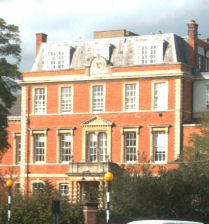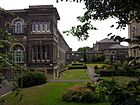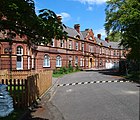
Florence Nightingale was an English social reformer, statistician and the founder of modern nursing. Nightingale came to prominence while serving as a manager and trainer of nurses during the Crimean War, in which she organised care for wounded soldiers at Constantinople. She significantly reduced death rates by improving hygiene and living standards. Nightingale gave nursing a favourable reputation and became an icon of Victorian culture, especially in the persona of "The Lady with the Lamp" making rounds of wounded soldiers at night.

The Royal Buckinghamshire Hospital is a private hospital in Aylesbury, Buckinghamshire. It is a Grade II listed building.

Fort Pitt is a Napoleonic era fort on the high ground of the boundary between Chatham and Rochester, Kent.

Woolwich Common is a common in Woolwich in southeast London, England. It is partly used as military land and partly as an urban park. Woolwich Common is a conservation area. It is part of the South East London Green Chain. It is also the name of a street on the east side of the common, as well as an electoral ward of the Royal Borough of Greenwich. The population of the ward at the 2011 Census was 17,499.

The Royal Victoria Hospital or Netley Hospital was a large military hospital in Netley, near Southampton, Hampshire, England. Construction started in 1856 at the suggestion of Queen Victoria but its design caused some controversy, chiefly from Florence Nightingale. Often visited by Queen Victoria, the hospital was extensively used during the First World War. It became the 28th US General Hospital during the invasion of mainland Europe in the Second World War. The main building – the world's longest building when it was completed – was entirely demolished in 1966, except for the chapel and former YMCA building, which still survive. The extensive outbuildings, which once occupied a vast acreage of land to the rear of the main building, finally succumbed in 1978. The site of the hospital can be seen and explored in Royal Victoria Country Park.

Woolwich Garrison is a garrison or station of the British Army. Geographically it is in Woolwich, in the Royal Borough of Greenwich. In terms of command, it is within the Army's London District.
Sir Douglas Strutt Galton was a British engineer. He became a captain in the Royal Engineers and Secretary to the Railway Department, Board of Trade. In 1866 he was a member of the Royal Commission on Railways. From 1869 to 1875 he was Directory of Public Works and Buildings.

Queen Elizabeth Hospital is a hospital in Woolwich in the Royal Borough of Greenwich. It was opened in March 2001 and serves patients from the Royal Borough of Greenwich and the London Borough of Bexley. The hospital was built to accommodate the services previously provided at Greenwich District Hospital and Brook General Hospital, and is a Private Finance Initiative hospital. It is managed by the Lewisham and Greenwich NHS Trust.

Alice Fisher was a nursing pioneer. During her brief career at the Philadelphia General Hospital (PGH) she improved the standards of care at the institution and created the hospital's nursing school.
Rosalind Frances Nash, née Shore-Smith was a journalist and co-operator, and the niece and confidante of Florence Nightingale. She assisted in some of Nightingale's publications, and wrote on her behalf to Karl Pearson, when Pearson was writing his biography of Francis Galton.

British Military Hospitals were established and operated by the British Army, both at home and overseas during the 19th and 20th centuries, to treat service personnel. They varied in size, purpose and permanence.

The Royal Belfast Hospital for Sick Children is a specialised government children's hospital and medical centre in Belfast, Northern Ireland. It is managed by the Belfast Health and Social Care Trust and is the only hospital in Northern Ireland dedicated to children.

Cambridge Military Hospital was a hospital completed in 1879 in Aldershot Garrison, Hampshire, England which served the various British Army camps there. During World War I, the Cambridge Hospital was the first base hospital to receive casualties directly from the Western Front. It was also the first place where plastic surgery was performed in the British Empire under Harold Gillies. It is now the residential estate Gun Hill Park.
Mary Stanley (1813–1879) philanthropist and nurse, is best known for her dispute in the Crimea with her friend Florence Nightingale.

Pendlebury Children's Hospital was a children's hospital in Pendlebury, Salford, England. It was managed by the Central Manchester University Hospitals NHS Foundation Trust.

The Brook General Hospital was the westernmost of three hospitals simultaneously situated on Shooter's Hill in southeast London in the Royal Borough of Greenwich. It closed in 1996, and most of its buildings were subsequently demolished.
Beatrice Isabel Jones, was a British nurse who, after serving in several civilian hospitals, volunteered for military service. She served in the Second Boer War in South Africa and then later served during the First World War in Baghdad as matron-in-chief of Mesopotamia. She was one of the inaugural recipients of the Florence Nightingale Medal.

The Miller General Hospital was a hospital in Greenwich, London from 1884 until 1974. It was developed adjacent to an earlier dispensary, and was the first British hospital designed with circular wards, and one of the first to have an X-ray department.

Dulwich Community Hospital was a hospital located in Dulwich, in South London.
Jessie Lennox (1830-1933) was a British nurse, trained at Florence Nightingale's school of nursing. She is also known for accompanying the writer Anna Mackenzie and Mary Livingstone, wife of David Livingstone, when they travelled to Africa to find him in 1862.























